The September Equinox is here. It is one of the two dates every year in which the Sun ‘passes’ directly over the Equator, the divider of hemispheres – Latitude Zero˚.
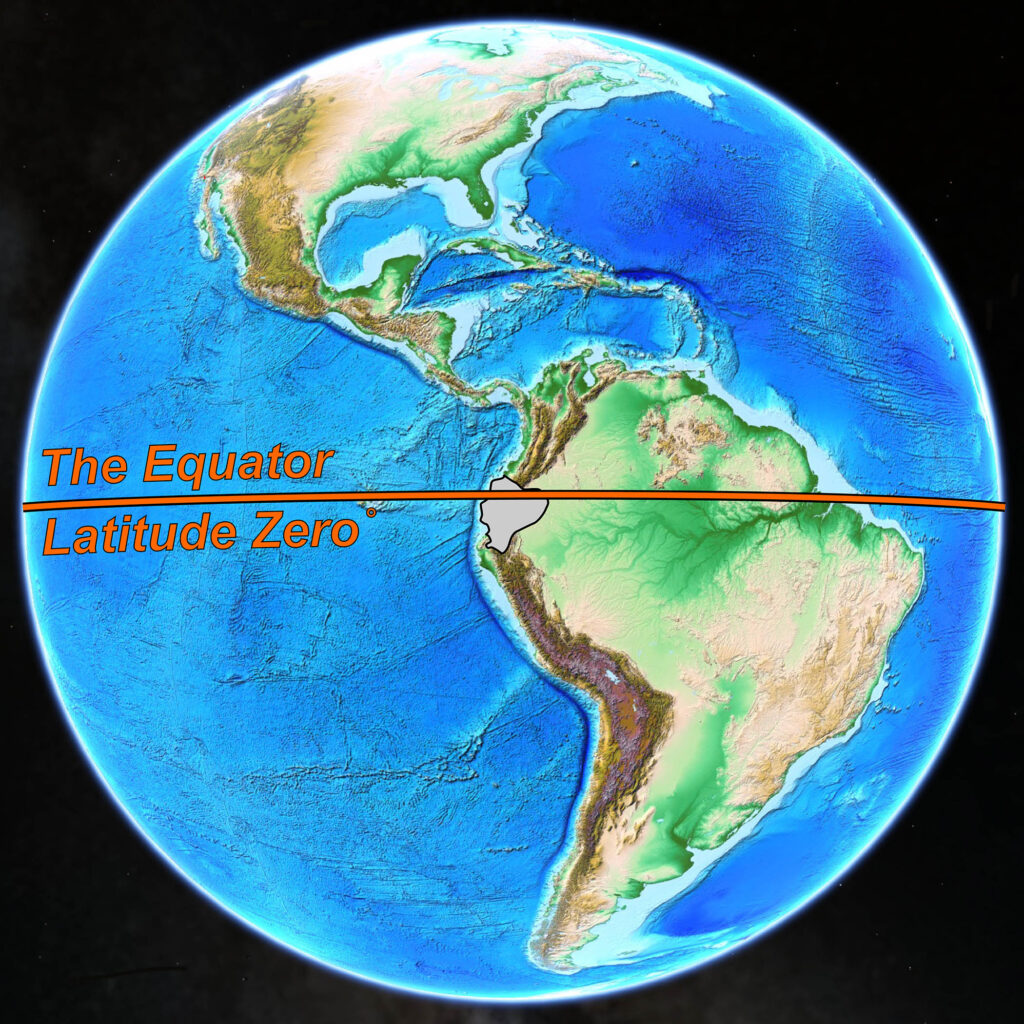
The Equator, Latitude Zero (0˚), transecting Ecuador (gray polygon).Ecuador rightly celebrates its position on the Equator and at Ciudad Mitad del Mundo (Middle of the World City), some 30 kilometers to the north of Quito, there’s a park with a monument dedicated to the boundary between the hemispheres. Here, right on the Equator, a monolithic stone tower is capped with a globe, plus a prominent yellow line traverses the park cutting the world in two.
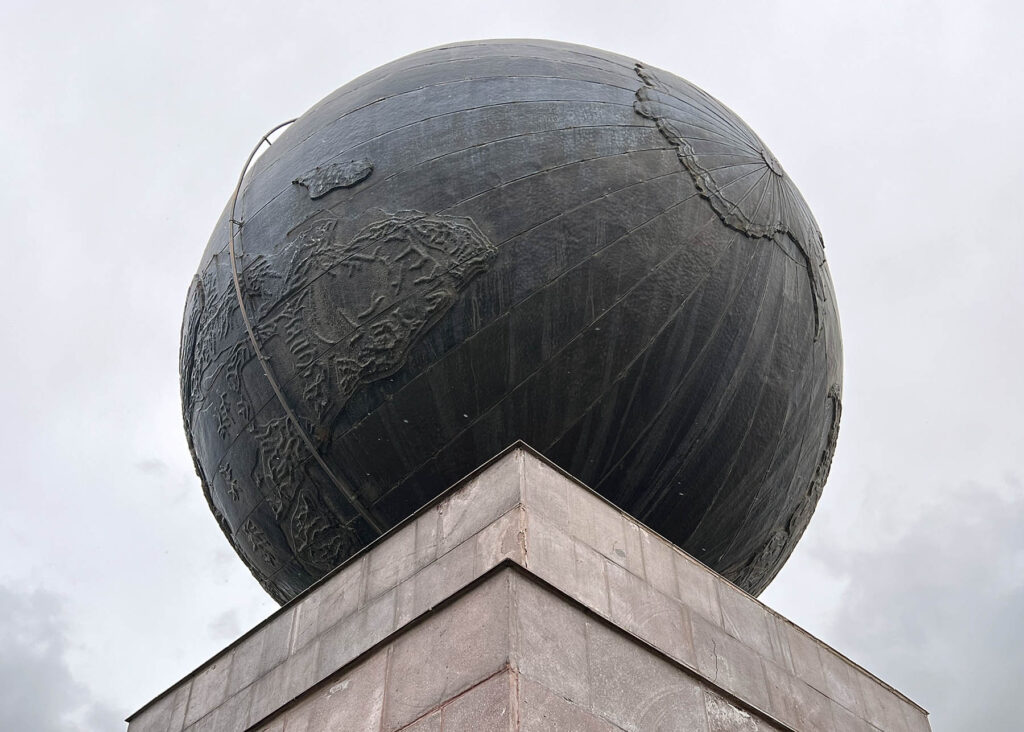
The globe atop the monument at Mitad del Mundo.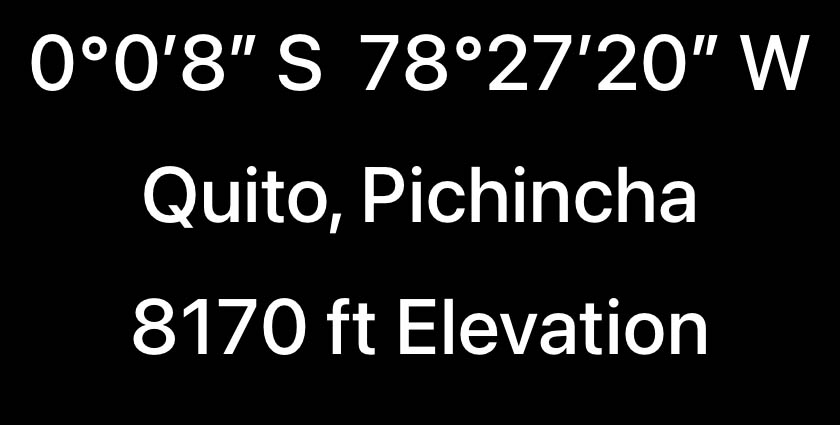
Or does it?
On my visit to Mitad del Mundo, while straddling the yellow line, the GPS receiver on my phone duly reported my latitude as 0˚ 00’ (minutes) 08” (seconds) South- that’s eight seconds of arc away from the Equator.
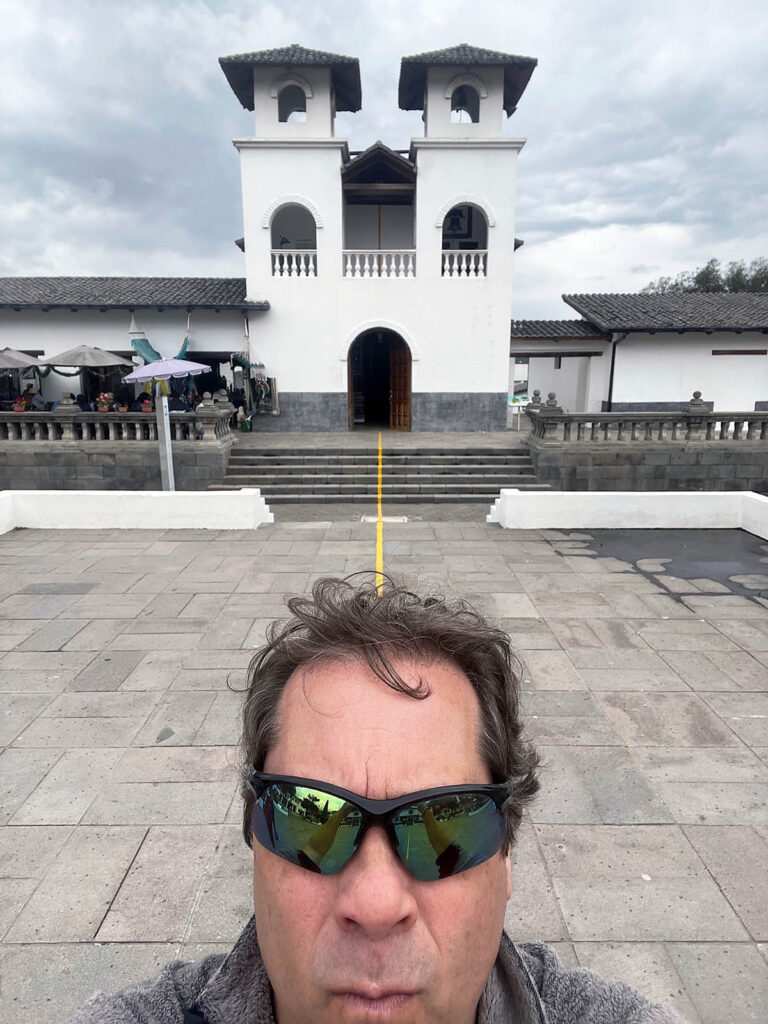
The Equator (or is it?), it's the yellow line emerging from my head. The southern hemisphere is on the rightMy goodness, what’s going on here?
The Earth’s radius is well known, and has been reasonably well known since antiquity; the polar radius is 6,357 km while the equatorial radius is 6,378 km. To circumnavigate the planet – going from the equator to the North Pole and then onward to the South Pole and finally back north to the Equator would be a journey of just over 40,000 km and it’d cover 360˚ of arc.
From that we get
40,000 km / 360˚ of arc = 111 km per degree of latitude
Let’s convert to minutes of latitude
[111 km/ degree of latitude] / [60 minutes/ degree of latitude] =
1.85 km per minute of latitude
Now convert to seconds of latitude
[1.85 km/ minutes of latitude] / [60 seconds/ minute of latitude] =
0.03 km per second of latitude or ~30 meters
Thus, 8 seconds of latitude equals about 240 meters (271 yards), the glorious yellow line and the attendant monument are some 240 meters off the mark.
At first, I was shocked. How could this edifice not be in the right place? But then I realized that 8” of arc is 1/450th (0.0022˚) of a degree. That’s a tiny angle.
At William & Mary, students in my Physical Geography: Earth’s Environmental Systems class estimate the latitude and longitude of the Sunken Garden using some rather old school technology consisting of a wooden staff, a ruler/tape measure, and a watch. On a sunny day, the staff and measuring tape enable us to determine the solar elevation angle at local noon and from that observation we can calculate our latitude.
For instance, on the September Equinox at the Equator, the sun is directly overhead at local noon (solar elevation angle = 90˚, that’d be the solar zenith angle) and consequently there’d be no shadows cast from vertical objects. On that same Equinox, at local noon in the Sunken Garden a vertical staff casts a northward facing shadow: for a 30-cm staff, a 22.6-cm shadow is cast and from that geometry we get a solar elevation angle of 53˚.
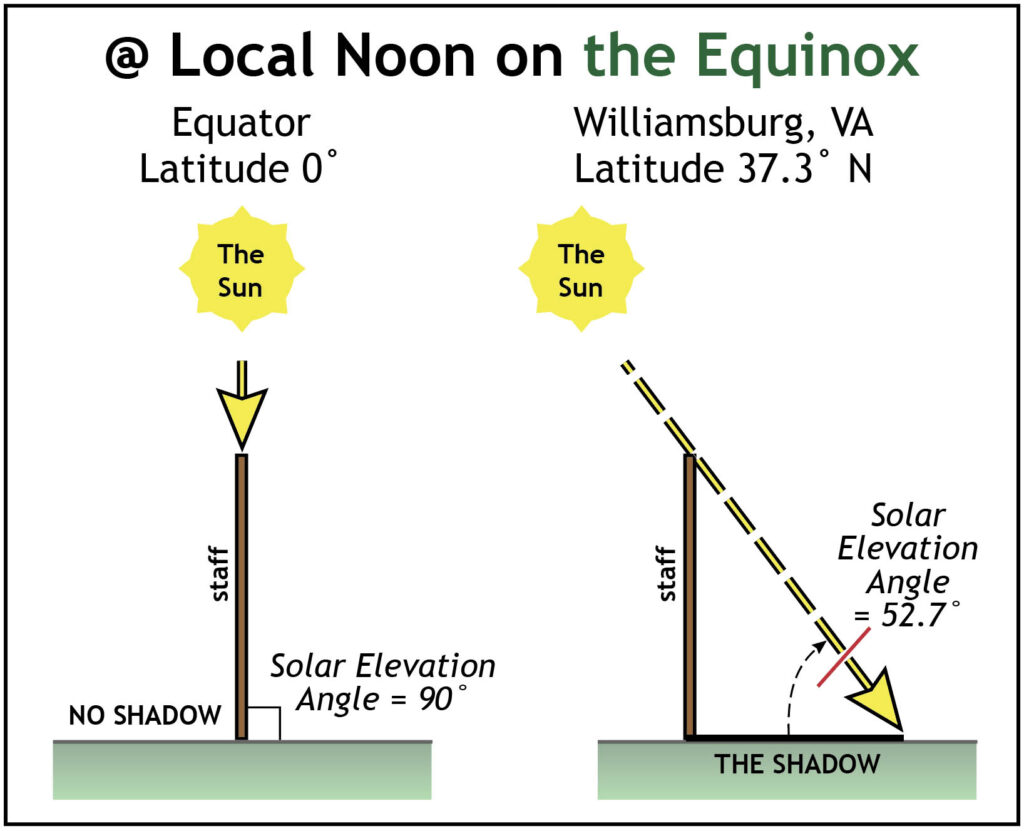
Local Noon on the Equinox at the Equator and in Williamsburg, Virginia.We can determine our latitude by simply subtracting the solar elevation angle from 90˚.
At the Equator: Latitude = 90˚ – 90˚ = 0˚
In W&M’s Sunken Garden: Latitude = 90˚ – 53˚ = 37˚ North
With this method about the best that we can do is estimate the solar elevation angle to the nearest degree, so I’ll temper any criticism of 8” arc seconds:). With a sextant and a steady hand, we ought to be able to measure an angle to the nearest minute (1/60th of a degree).
The solar elevation angle is a big deal because it’s the most important control on the amount of solar insolation received at a given location. The solar elevation angle changes over the course of the day – increasing from sunrise to local noon and then decreasing to sunset. But it also changes with the seasons, as illustrated by the graph below and that’s a first order driver of local climate.
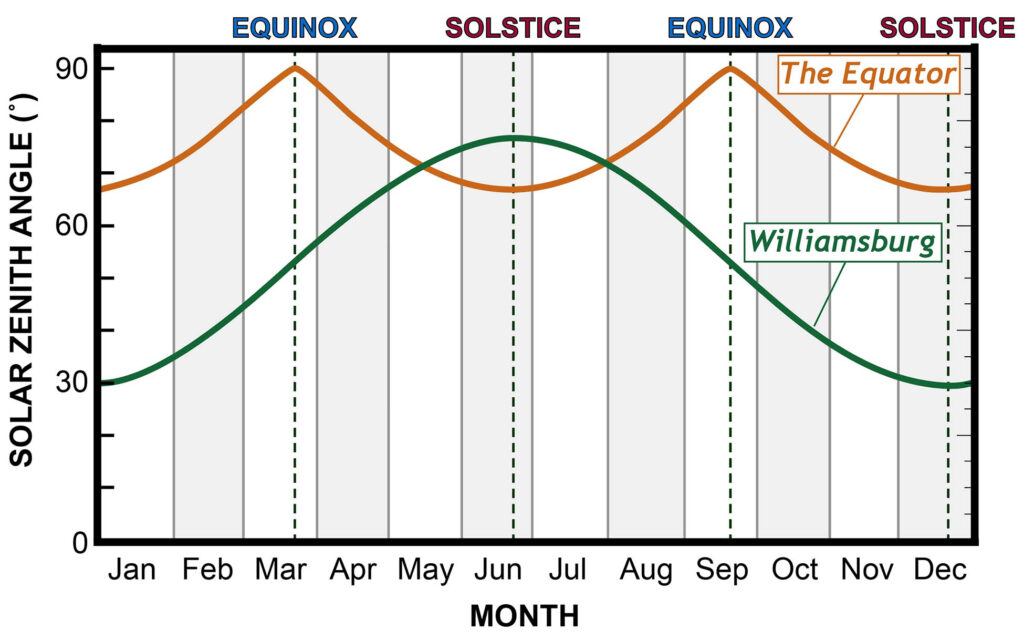
The solar zenith angle over the course of the year at the Equator and in Williamsburg, Virginia.For approximately 2.5 months of the year (from mid-May to the beginning of August) the solar zenith angle in Williamsburg (a mid-latitude locale) is actually greater than it is at the Equator.
My wife Jennifer accompanied me to Ciudad Mitad del Mundo and was more than amused by my ‘freak out’ over the discrepancy between the yellow line Equator and the actual Equator. She’s a sociologist and adroitly noted that the Equator is nothing more than a social construction, so I should just chill out.
Perhaps she is right, what do you think about the Equator – its relevance as either a mere social construct or as an important part of a planet’s anatomy?
Guys Chuck Bailey is the best geology professor EVER. Sunken Garden Physical Geology mentioned!!!
This was a fun read! It’s fascinating how the monument is actually around 240 meters off the true center (equator), just by 8 seconds of latitude. While it isn’t visible to the naked eye, modern GPS makes those subtle differences pretty clear. I’d say the equator is both a social construct and also it has it’s importance to the Earth’s anatomy because it’s where the sun passes overhead leading to how the planet’s seasons, climate, and life function.
To me the equator is one of those little joys that is universal. I remember standing in line with hundreds of other humans to take a picture at the prime meridian at the Greenwich Observatory. It brings me back to a child-like joy of looking for the anomalies at the map: the furthest corner, the meeting point of three states, a tiny island named after a holiday. I still have the wonder now that I’m going to the places I see on maps, even though one realizes that it’s essentially the same as the rest of our blue marble.
I found this article to be very interesting, but I was disappointed that you were not truly on the equator line. However, I do think the equator is an important part of the Earth’s anatomy because we need a mid-point and a 0-degree line of latitude to base our calculations on when determining our position to the sun.
The Equator is definitely an important part of the planet’s anatomy, especially in evaluating climate and currents of air and water. However, its role as a social construct should not be overlooked. It denotes the beginning of the global south, a widely underdeveloped region of the world often left behind by the superpowers of the Northern Hemisphere. It divides a more developed, temperate region of the world where most of the land is concentrated with a more sea-centric region of less developed countries and places left out of the minds of many in the Northern Hemisphere. To the many north of the south, the lands below the Equator feel exotic or unexplored, as compared to the well-tread north. It’s interesting to shift between the two geographical and sociological interpretations of the equator, and both should be intertwined to portray the full picture of what the Equator means to us humans that happen to live our lives up and around it.
Loved how much information is PACKED into this article while still being super fun. Wish my physical geography professor taught like this…..oh wait!! He does! Shoutout Professor Bailey. He’s the GOAT for professors.
This article is fascinating! I agree with your rightful judgements of the misplaced equator. Understanding the true equator is essential to us. it is the metaphorical duct tape that holds the Earth together. Without that knowledge, we would unravel.
I enjoyed reading your post and learning about the Mitad del Mundo in Ecuador. In my opinion, the equator is an important part of a planet’s anatomy as it is used for many calculations such as finding latitude and determining the day of a solstice or equinox. The equator may be an imaginary line, but its significance is evident.
I would like to thank Professor Bailey for this amazing opportunity to read and provide insight into this awesome article! This relates back to our recent fun (problem) set where among some many other super cool concepts we had to use solar elevation angles and subsolar points to find our location on the Earth! I think that the equator is an important line of latitude because those calculations can be based around it and when it comes to astronomical seasons, the subsolar point hitting that 0-degree latitude is what starts off the fall and spring seasons.
The only holidays I celebrate are the equinoxes and solstices, I think all the other ones are astronomically unimportant.
I believe the equator can exist as both a social construct and a scientific one. Though I see why your freak out over things being off place was valid, and a great observation to make that it was a little off!
First off, shout out Physical Geography! Chuck Bailey literally rocks.
Anyways, the equator itself is just a construction, like the wife says. There is no literal, visible line splitting the earth in two. But for us humans, these constructed concepts are necessary. We need to define and set what an “equator” is so we can perform basic navigation. It is a “basis” of positioning. These concepts also help us understand the earth and the relevancy of position within regards to natural occurrences.
Sometimes, though, these concepts do not need to be taken so literally (except on a problem set).
That is seriously messed up… 271 yards off? Someone better lose their job over this. #TouristTrap
It’s a shame that you traveled all that way just for the monument and line to be incorrectly placed; I would have been a little disappointed. I believe the equator is a crucial part of the earth’s anatomy, as it is our center of reference for measuring latitude and is typically the warmest region on the globe. Overall, very gneiss article!
This article was interesting. Personally, I think that 240 meters from the monument to the actual equator is too great a mistake to forgive. Regardless of whether the degree difference is relatively negligible, that’s just about a quarter of a kilometer; you would have to walk something like 3 minutes to correct it. The whole point of the monument should to be a place where you can physically see the equator, and if it turns out that the placement is so inaccurate that it would force someone to take a short walk to be at the actual thing, it completely defeats the purpose in my opinion. The equator may be a social construct, but it’s a social construct that has helped humanity with navigation since time immemorial, and therefore it deserves better than this.
Personally, I like to believe that there is importance in the equator because it plays a crucial role in people’s understanding of geology, whether it be learning about the seasons in elementary school or determining longitude and latitude for scientists at NASA. However, making this point into a tourist destination is a clear sign of how it is also a social construct, and is an example of our growing consumerism as a society.
I really enjoyed reading this article and learning more about the Equator and the September Equinox. It was shocking to find out that the monument is not actually on the Equator since I always assumed that it would be in its correct spot. However, once it was explained that 8” of arc is actually 0.0022 degrees, then it sort of made sense on how this mistake occurred. Although I’ve never really given it much thought, I think that the Equator is an important part of the Earth’s anatomy as it is the zero-degree line of latitude and helps us determine crucial geographical coordinates. It allows us to better understand global climate, the reason for the seasons, and so much more.
“Perhaps she is right, what do you think about the Equator – its relevance as either a mere social construct or as an important part of a planet’s anatomy?”
To answer your question, I think of the Equator as an important part of our planet’s anatomy, since it is taught incredibly early on as the “belt” that wraps around our world and splits the Earth into two hemispheres. The social construct aspect of the equator does not apply here in my opinion, since regardless of where it is, its use is as a line that divides the world.
If the equator line gets to be two football fields off, then I should get some grace on my problem set. Or maybe I should just look into sociology, which is apparently cushy and easy-going.
This was a fun read! The part about the Sunken Garden experiment was especially interesting. Using something as simple as a staff and shadow to calculate solar elevation and latitude shows how much we can learn through simple observations. Thanks for making the concept clear and engaging!
Only a little bit into the article and the activity at the sunken garden was mentioned and I thought to myself “Hey I remember doing that!” I believe that the equator is an important part of Earth’s anatomy as it helps us with various calculations. It was pretty funny reading that your wife told you to chill out over the monument being off center of the equator.
Equator? I hardly know her!
Oh wait… I do! All thanks to the amazing Professor Bailey and his riveting blog post. It is really interesting how just 8 seconds of latitude can equal such a significant distance. Totally accuracy is something that is difficult to come by in geology, even with using the solar elevation angle and by using calculations. Even if the equator is a social construct, we as a society have deemed it important and treat it as a finite aspect of life. Knowing exactly where you stand in relation to the equator can be a comfort is this huge, vast world… or when working on a problem set for Geology 110.
I can’t believe that’s not the equator! I had no idea that the yellow line was 240 m off. The equator itself isn’t fake; it’s a physically defined great circle, and the mismatch is probably just old survey/datum vs. modern GPS
I really enjoyed this post. It made me think differently about something I’ve always taken for granted. The GPS discrepancy at Mitad del Mundo was surprising, but I liked how you broke it down with the math and showed how small that error really is. I also appreciated the example from the Sunken Garden here at William & Mary; it’s cool how simple tools like a stick and a tape measure can help us estimate something as big as our latitude. The solar elevation angle comparison between Williamsburg and the Equator was eye-opening, too. I hadn’t realized that mid-latitude locations can sometimes receive more direct sunlight than the Equator. And your wife’s comment about the Equator being a social construct honestly stuck with me. It’s a good reminder that even scientific truths can be shaped by how we choose to represent them.
That is so lame that the yellow line is off by a whole 240 meters, but nevertheless, this article was very interesting and informative.
Though the name assigned to it is simply man’s creation, the Equator is defined by measurable qualities which, in my opinion, make it much more than a social construct. It’s comparable to how the names of hours in a day are technically a social construct, but the passage of time is dictated by science and mathematics. Basically, if the equator is a social construct, then any scientific phenomenon/discovery labeled with a name must be one as well.
Loved being able to read the blog and see W&M students MENTIONED! I think it’s crazy that you traveled so far to see the equator to realize that it was actually 240 meters off. Basically, seemed like a tourist trap. The equator is such an important part of how we view and conceptualize the World. Even though it’s an imaginary line they should still try to make it known correctly.
I think it’s interesting how much of the world’s landmass lies above the equator. So much of the world’s history and current politics occur above it; we can’t forget how much happens below, though.
After reading through this article I’m not sure what’s hotter: the Equator, the Solstice, or Professor Chuck’s blog posts.
Clearly the monument at Ciudad Mitad del Mundo is a tourist trap and a complete scam, given the very large margin of error in 240 meters (1/450th of a degree)! This fascinating discovery must be presented to Ecuadorian travel ambassadors immediately so that the scam operation carried out by the city can be stopped! The equator is not just some arbitrary line; it is a major influence on the climate, the widest part on the globe, and is a reference point for measuring longitude. Your ‘freak out’ is completely valid, and your wife is wrong.
I thought that this post was really cool!!! 240 m cannot believe they messed that up – the equator is an integral part of the Earth.
Your wife, Jennifer, is low key right. All of science is a mere social construct made by humans.
240 meters is a lot of meters. Great article Professor Chuck. Shoutout geography class.
Super cool! At first I was confused why the solar zenith angle appeared so different at the equator versus Williamsburg (on the chart), but it makes sense that the shape would be mirrored/flipped upside down once it passes 90 degrees. I also wondered if the Mitad del Mundo line could shift INTO the correct spot over time, as the South American Plate shifts?! Alas, it looks like the plate is slowly moving westward, not northward. Re sociology vs. geology: the difference in location for the accepted “equator” vs. the actual geologic equator sorta reminds me of true north vs. magnetic north vs. grid north—those locations serve different purposes, but I guess this line’s purpose is mostly tourism! And perhaps a purpose that is appreciating our planet’s form and solar cycle, even if the location isn’t quite right 🙂
I don’t know where this guy gets off trying to dictate where the equator “should be” or “actually is,” the line in the picture looks pretty center to me. I should know, I know what the middle looks like. All the pictures in my house are straight, I am an expert when it comes to this. Ask me anything about measuring the middle, I can tell you, everyone says I am the best at centering, the BEST. The best in the WHOLE WORLD. If this is what this guy thinks about the equator, I’d hate to hear what he has to say about the shape of the earth. Don’t believe the Fake News!!!
Very interesting article! Honestly though, it’s kind of disappointing that the yellow line isn’t exactly right, especially in a town that has a lot of tourism centered around the equator. I’d also ‘freak out’.
Equator? I hardly know her!
Oh wait…I do! All thanks to Professor Bailey and his riveting blog. Wow the equator may be a social construct, we, as the society have determined it as an important and crucial finite aspect of our lives. In a way it is comforting that in this big world, we can know exactly where we are in relation to the equator, using longitude and latitude.
Even if someone were to believe the equator is a social construct, its importance as a landmark in making measurements about the Earth cannot be overstated. Without the Equator, there would be no standard for where to begin to measure in terms of North and South, and that goes without even mentioning the fact that the Sun is directly above it on the equinox.
I think it is extremely interesting how your wife thinks of the equator as nothing more than a social construct. It is very interesting because they are technically man made lines that don’t truly exist. Even if they are tools we use to better understand things about our planet I feel like it is a good reminder that not everything is so literal but concepts and people are learning more and more about the earth everyday.
This was very interesting to see how the equator isn’t set exactly at 00’00. I think the equator plays both a sociological and geographical role for the sake of dividing the Earth and setting a standard for latitude.
I think it’s really interesting how observations can be made through simple every day things like a staff and a shadow.
Fun to see the math and science in our lecture lessons come to life in a real and applicable way – like someone else pointed out, that 240 meter inaccuracy is a sackable offense.